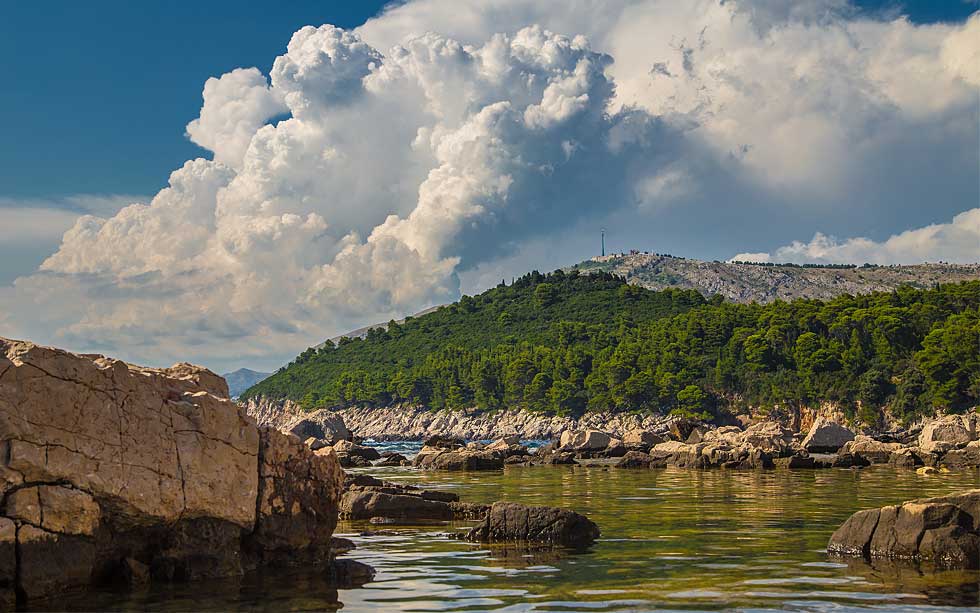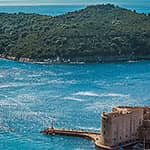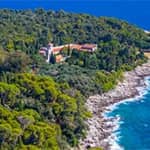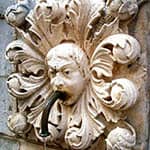Whosoever claims Lokrum for his own personal pleasure shall be damned!
The legend is associated with the founding of the Benedictine monastery on the island of Lokrum. According to this legend, a great fire erupted in Dubrovnik somewhere around the year 1023. The inhabitants of Dubrovnik made a vow to Saint Benedict that they would construct a monastery in his name if the city would be spared. The fire was extinguished instantly, and the thankful citizens of Dubrovnik then built a Benedictine monastery and church on Lokrum, which they dedicated to the Blessed Virgin Mary.

In reality, the fact remains that the Benedictine monastery was founded in the year 1023, for real copies of the original documents dating to the 13th century do exist. Further, the fact remains that in 1023, and precisely on the Day of St. Benedict, most of Dubrovnik was consumed by fire, as it was mostly constructed out of wood. Some even insist that the archbishop's palace was also destroyed.
Lokrum Island with BLUE cave and panoramic view of Old town
Experience the best of Dubrovnik from the sea with the unforgettable speedboat tour to Lokrum Island and the famous Blue Cave. Cruise along the stunning Adriatic coastline, marvel at Lokrum’s dramatic cliffs, before enjoying two hours of free time to explore the island’s botanical gardens, historic ruins, and hidden gems. Dive into the magical Blue Cave, a must-see natural wonder, and snorkel in crystal-clear waters teeming with marine life – all gear is provided on the boat! Modern, comfortable speedboats are captained by friendly, local skippers, ensuring a safe and exciting ride.
The establishment of the monastery and the donation of the land on Lokrum were decided on by the Dubrovnik archbishop Vital and by the preses, the Latin term for the head of the city of Dubrovnik, Lampridija, together with all the aristocracy. The Benedictine founders were the monk Peter from St. Mary's Monastery in Tremit near Puglia, and the Dubrovnik priest Leo, who took the vows of a Benedictine monk at this time. A direct link was established with the Benedictine seat in Monte Cassino, immediately after the establishment of the monastery.
The Benedictine's also had a monastery and church in Rožat in Rijeka Dubrovačka by either the end of the 11th or the beginning of the 12th century. Desideria (1058-1087), the Abbot of the Benedictine monastery in Monte Cassino, ordered the fabrication of the church doors for the monastery in 1066. The door posts were covered with silver plaques that depicted the names of all the churches belonging to the monastery. Later, the Abbot Oderizia II (1121-1126) added on sixteen more plaques with the names of new churches, which also lists St. Mary's Church in Rožat. The Benedictines abandoned the monastery during the 12th century.
The descendants of Count Savin in Dubrovnik took advantage of this and appropriated the monastery with its entire property. The Lokrum monks protested sharply against this move, as Savin's bequest indicated that the monastery would belong to the monks if there were no Benedictines from Monte Cassino in the regional monastery in Rožat. On this basis, the Dubrovnik consuls passed a decision on April 09, 1198, whereby the monastery with its church and property in Rožat became the property of the Benedictine monastery on Lokrum. The Pope's legate, Ivan, who was the curate of the Apostolic Succession, threatened anyone who would oppose this with a curse.
Game of Thrones Lokrum Special in Dubrovnik
While most Game of Thrones tours focus on the filming sites within Old Town Dubrovnik, this unique tour takes you beyond the city walls to Lokrum Island, known as Qarth in the series. Ideal for GOT enthusiasts, this tour offers the chance to sit on the original Iron Throne, gifted to Croatia after the series wrapped and now located on Lokrum Island. Explore Game of Thrones locations in both Old Town and Lokrum Island, ensuring you don't miss lesser-known spots with the help of a knowledgeable guide. What's included in the tour are official licensed tour guides who were part of the production, a photo opportunity on the official Iron Throne, and the chance to stay on the island afterward to swim, hike, or cliff dive. The entrance fee to Fort Lovrijenac is 15 Euro per person, but it's free with a city wall ticket or Dubrovnik Pass. The ferry ticket to Lokrum Island is 27 Euro for adults and 5 Euro for kids aged 5-15.
However, from 1295 to 1321, the Benedictines gradually abandoned Rožat, moving completely to Lokrum. In the Dubrovnik region, there was one more male Benedictine monastery, the "St. Andrew of the open seas" (in pelago). In the 12th century, they owned the entire island of Mljet with its monastery and the Church of St. Mary. Mention should be made of the notable cultural workers in the Benedictine order, the poets Mavra Vetranoviæ and Ignjat Ðurdeviæ, as well as the historian Mavra Orbin.
The legend of the Lokrum curse originated when a French army general ordered the closure of the monastery and the expulsion of the Benedictines. The Dubrovnik aristocratic families Gozze, Pozza and Sorgo were chosen to convey these orders s to the monks.
According to legend, the monks were aghast with the French general's order and did all they could to remain where they had resided for centuries. When all else failed, one night they went to the Church of St. Mary to serve one last mass to God on the island. The monks donned their hooded cloaks and proceeded to circumnavigate the island in a long and solemn, single-file procession. Symbolically, as a curse, they turned their lighted candles upside-down towards the earth, so that the flame licked the wax, which left a melted trail.
They went around the island this way three times, which took the entire night, ceremoniously chanting the terrible and harsh words of the curse:
"Whosoever claims Lokrum for his own personal pleasure shall be damned!"
At dawn, dead-tired, they embarked on a boat and left the island, never once looking back. And, nevermore did they return.
The legend says that the curse laid on the island soon began to take effect. One of the three Dubrovnik aristocrats jumped out of a window, the other drowned in the sea on the way to Lokrum, and a servant killed the third.
Captain Tomaševic became the owner of the island following the fall of the Republic. He was an extremely wealthy man, but he suddenly became bankrupt soon after having purchased the island, which forced him to sell Lokrum. It was sold to the archduke Maximilian, the younger brother of the Austrian Emperor Francis Joseph I.
Maximilian discovered Lokrum by chance in 1859 when the ship "Triton", following an explosion, sank in front of Lokrum. As Navy Commander of the Austro-Hungarian Monarchy, he had to honor the dead seamen. On this occasion, Maximilian set foot on the island for the first time.

He saw the ancient Benedictine monastery from the 11th century, which had been damaged in the earthquake of 1667. After the whirlwind of Schonbrunn, he was impressed by the silence of the thick aromatic forest. He decided to purchase the island and to turn it into his summer manor already during the first night that he spent in a monk's cell of the old monastery. He added on a belvedere, placing his initials everywhere, even on locks and keys, so as to emphasize his ownership of Lokrum. He had no idea that his actions only further provoked the curse that was directed against the personal ownership of Lokrum.
Maximilian, as the owner of a paradise, enjoyed marking pathways throughout the forests of pine, bay, palm, cypress, aloja, oleander, orange, lemon, lilies and roses, all around the island and up to its peak, to the fortress "Fort Royal" built by Marmont in 1806, when his troops entered in Dubrovnik. He settled colonies of canaries, parrots and peacocks on the island. He planted vanilla and Indian fig trees. Here, he read verses by Heine out loud, while his Belgian wife, princess Charlotte, embroidered silk pillows. So close, yet so far from Europe and court scandals, they thought themselves to be the happiest married couple on earth. Looking on all of this intoxicating and moving beauty, Charlotte would write letters to her cousins and friends about the happiness that she and Maximilian enjoyed, after having spent hours playing the piano long into the night.
Then, duty, or most probably the Benedictine curse, took him to Mexico, where he was chosen emperor in 1864. After only three years, he was taken prisoner by the soldiers of the rebellious general Juarez. He was shot in Quereteri on June 19, 1867.
The island was then offered for sale to the Dubrovnik County. Legend says it would not buy it even for the trifle sum of 20,000 silver coins. Awhile later, it was bought by Dujmovic from Poljica, who originated from a family that had once received the title "conte de Polisa" from Venice. He also met with quick and complete financial disaster. The island was then purchased by the lawyer Dr. Jakopovic from Budapest, who was renowned for managing some of the business affairs of the emperor Francis Joseph I. However, shortly after having purchased the island, it was discovered that he had quite illegally assigned himself the title of Doctor of Legal Sciences, and that he was in fact - a barber! The investigation, which had caused a huge scandal in Viennese and Budapest societies, revealed that he adopted this title from a dead soldier following the revolution in 1848. His property was not confiscated, thanks to the Emperor's intervention, in an effort to lessen his own personal shame, but he was totally ruined morally. Thrown out of the society that he was accustomed to, he died shortly, unappeased and shamed.
His nephew, a young Hussar officer, inherited the island. Already on the first day of his arrival, a very strong wind overturned his boat between Dubrovnik and the island, and he drowned. The Habsburg's then reappeared as the owners again. Rudolf, the heir to the throne and the only son of the emperor Francis Joseph I, and the empress Elisabeth of Bavaria, took a liking to Lokrum. He invited his wife, Stefanie, to Lokrum. They stayed there for a time, adding exotic plants to the island's park. However, Rudolf soon fell in love with the beautiful mistress Maria Vecer. Together, in the Mayerling palace, they committed the sensational double suicide, which was never quite explained.
The empress Elisabeth (1837-1898), prompted by stories of the curse, decided that the royal family had to rid itself of this island. Before leaving for Corfu, she offered it to the Benedictines, in the hope that the curse would thereby be lifted. However, they remained faithful to the vow made by their brothers previously that they would never return to this island and turned down the offer from the royal court. The emperor's family, obsessed with the fear of losing yet another member, after having already lost two, gave its money to the Dubrovnik Dominicans for them to purchase the island as the new owners, under the condition that any of the Habsburg's could re-purchase the island when and if they so desired.
And so, there really was a femme fatale found to do this. At the auction that was announced for the sale of Lokrum, the bishop Josip Juraj Strossmayer appeared with an offer of 30,000 forinths through an intermediary, Mihovil Pavlinovic. However, a telegram ordered the auction to be stopped. The assumption that "someone from the emperor's household wished to buy Lokrum" proved to be true. It was the granddaughter of Francis Joseph I, Princess Elizabeth Windischgratz, who was the daughter of Rudolph, the heir to the throne. She persuaded him to buy Lokrum, which he did on October 01, 1879. Five years later, on May 27, 1888, he registered the island under his name. Shortly after her grandmother, the empress Elisabeth, returned to Geneva from Corfu in 1898, she was killed by the Italian anarchist Lucceni, in a case of mistaken identity.
And... the end of the Habsburg's is well-known. The eldest son of the archduke Francis Ferdinand who was killed in Sarajevo on June 18, 1914, finished as an agronomist: The princess Windischgratz fired shots in a nightclub in Prague at some dancer who was the mistress of her husband, and was then disinherited by her royal parents. Finally, in 1918, after exactly 700 years, the Habsburg's lost their crown as well.
But, this is not the end. The above-mentioned constitutes only a part of the story that ties the Lokrum curse to historically renowned persons. However, superstition also surrounded Lokrum. It expanded the legend of the Lokrum curse with countless stories and tales that were colored by metaphysics to such an extent that the historically true events, which were further warped and twisted by superstition over the centuries, resulted in a certain inexplicableness known as - the mystery of Lokrum.
The superstition became so widespread that no one could be found to live on Lokrum for a very long time. The palace servants would not on their life venture into the palace gardens at night, for demons would cut off the heads of their lovers in a dark erotic rage, and would sew their hearts onto their dresses. Stylish aristocrats, seeking change, loved to mix even with their male servants, so that they very carefully kept up this legend. Under its protection, they could rendez-vous freely at night in the garden of love.
Fantasy wove a number of mysterious stories around the Lokrum caves as well, where the seas rage during storms. Its echo resounds as earth's harsh blow to the cover of a coffin. According to old documents in the Dubrovnik archives, criminals were cast into the sea from the steep Lokrum cliffs during the Middle Ages, otherwise famous for its cruel punishments. A well-known legend describes how the ship of the English king, Richard the Lion-hearted, was cast upon the Lokrum cliffs during a fierce storm. The legend says the Bosnian king, Tvrtko, also found sanctuary amid the walls of the Benedictine monastery. But, Lokrum knew how to be merciful towards the unfortunate as well.
In 1859, the Austrian ship "Triton" exploded in the Lokrum canal. Only one survivor remained after the tragedy - a prisoner who was imprisoned in the bowels of the war ship for some crime. The whirlwind of the fierce explosion expelled the unfortunate wretch with remnants of the chain onto the shore, completely unharmed, while the rest of the crew perished. The Austrian Admirality entrusted the investigation of this catastrophe to a commander of the imperial fleet - Maximilian. He fell in love with Lokrum, purchased it and so started the wheel of fortune that led him to such a tragic end. During his stay on Lokrum with his wife Charlotte, the enamored Maximilian engraved a heart containing the first letters of his and Charlotte's name into a huge oak dating to the 14th century, located next to the palace. According to romantic legend, he thereby incurred hostility, as it was a historical oak, under which the Dubrovnik Senate met frequently. A storm appeared before he returned to the shores of Lokrum. Lightning struck this oak tree and the engraved monograms disappeared, leaving only the heart. This was considered as a sign of impending disaster.
After Maximilian's death, Charlotte visited Lokrum in the company of a count - her admirer. On approaching the island, she barely managed to avoid death, as her yacht overturned inexplicably, sinking quickly. Coral hunters saved her. According to legend, the same ones that cursed her while Maximilian was still alive. Legend has it that she experienced this misfortune because she was wearing a necklace made of the coral taken from the sea depths near Lokrum. According to tradition, the poor coral hunters had for centuries followed the perilous trade of their fathers in the hope that they would eventually come across a secret underwater cavern with a reef containing beautiful coral, and so become rich. After a long time, one day they really did find this reef, but it contained only one coral. Disappointed, they then cursed the aristocrat that would wear it.
The new owner of Lokrum became Rudolf, the heir to the throne. He spent his honeymoon here with his Stefanie. The story goes that Mount Srd shook when the young couple disembarked on the island shore. This small earthquake, it is said, was a forewarning of the misfortune to follow at Mayerling.
Queen Elisabeth, wife of the emperor Francis Joseph I, once visited the island. However, due to superstition, she refused to spend the night there. The archduke Francis Ferdinand and his wife Sophia intended to spend the summer of 1914 on the island, but were prevented by an assassin's bullets in Sarajevo.
Today, Lokrum is a quiet excursion site for tourists, and all these legends have contributed perhaps to the steadfastness of the citizens of the ancient Republic in keeping true to their own motto - famous and free.
Source: "Dubrovnik - between history and legend"
Writen by: Dr. Marko Margaritoni
The arrival and the departure to and from Lokrum island are organized from the Dubrovnik ancient Old Town port. Regular departures are available every 30 minutes during summer season.
Planing to visit Lokrum Island? Here is the Lokrum Island Ferry Timetable.
Dubrovnik legends and tales

The Legend of the Lokrum Curse
This Lokrum legend is connected to the establishment of the Benedictine monastery on Lokrum Island.
Read more: The Legend of the Lokrum Curse

The wretched woman of Lopud
The legend of the forbidden tragic love between a nobleman and a commoner girl.

Richard the Lion-Hearted´s vow
Regarded as one of the most distinguished Renaissance playwrights and prose writers in Croatian literature.
Read more: Richard the Lion-Hearted´s vow

City Walls Legends and Facts Tour
Gain a genuine understanding of Dubrovnik's life across different eras through tales of legends and customs.
